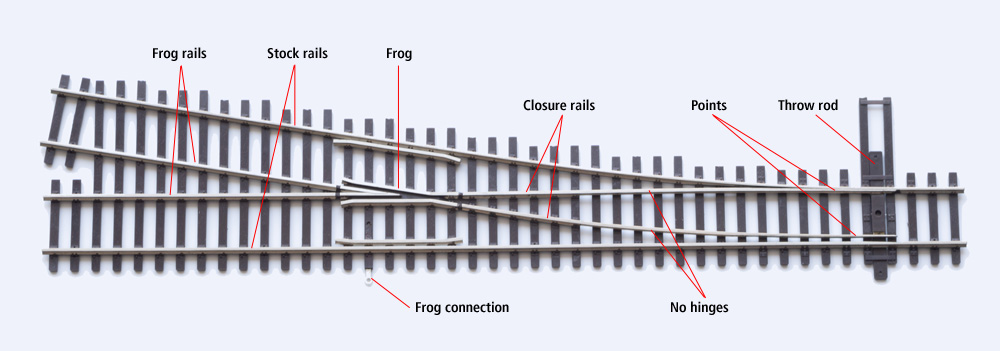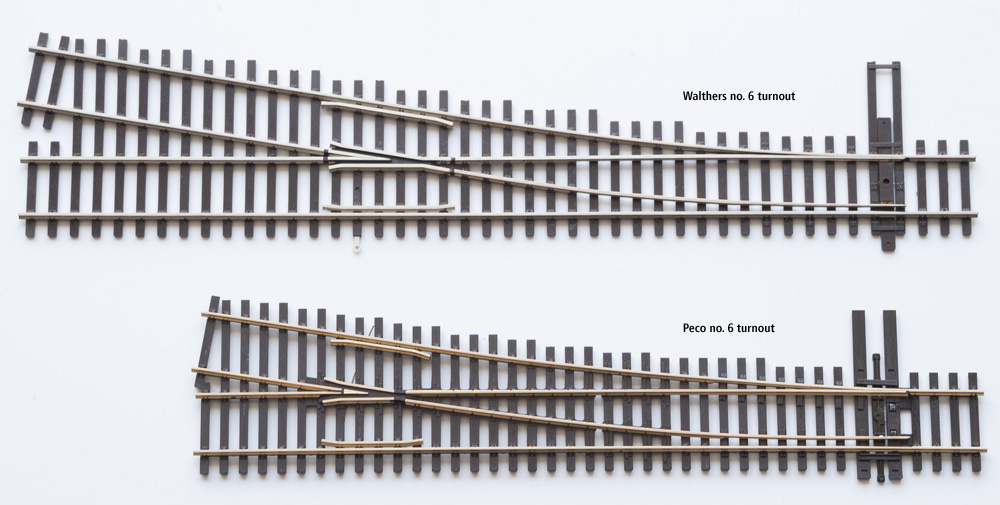
HO Scale Walthers turnouts introduction
Like their predecessors, the latest generation of turnouts is DCC friendly. Turnouts that are DCC friendly minimize the possibility of a short shutting down part of a model railroad due to metal wheels contacting adjacent rails that are at a different polarity. The new Walthers Track line turnouts are available in code 83 and code 100 rails. While the full offering isn’t yet out, the package for the code 83 indicates that the line will include turnouts from no. 4 to no. 10, a no. 6 double crossover, and curved turnouts in 20-20-inch and 24-28-inch sizes. The website shows that Code 100 will cover no. 4 to no. 6 turnouts. Searching the Walthers website shows the latest turnouts available.
Turnout features
The nickel-silver alloy used by Walthers is silver in color for those who want a more realistic-looking railhead. The thin-profile ties are brown with a wood-grain texture. Holes for track nails are started on the back side of the ties, but don’t go all the way through. Just drill out the ones you want to use.
A number of features make wiring this turnout simpler and quicker. The frog rails are internally connected to the stock rails. The closure rails are also internally connected to the stock rails. Another desirable feature is that the closure rails and point rails are all one piece – no point hinges to cause long-term conductivity problems. If you don’t power the frog, all you need to do is attach a feeder from each stock rail to your track bus. Minimal soldering means you’re less likely to damage your turnout and knock it out of gauge.
Probably the riskiest soldering operation on a turnout is powering the frog. The turnout features a terminal that sticks out the side to which you can solder a feeder wire. This keeps the heat away from the frog and keeps your turnout in gauge. When done, you might gently bend it down, or you can paint it brown or gray to hide it in your ballast.
Of course, there’s the age-old question, do you need to power your frog? If all your locomotives have stay-alive circuits, have all or many-wheel pickup, or long wheelbases, maybe you don’t need to. With the terminal sticking out the side of the turnout, this is a decision you can easily put off until you see if you have any problems with your locomotive fleet.
The switch rod features a spring to hold the points against the stock rail. If you’re using a switch machine that provides the holding pressure for you, you will want to remove the spring. The instructions tell you how to remove the cover on the back and take out the spring.
Turnout size
One thing that caught my eye when I opened the package was the length of the new Walthers turnouts. A Walthers no. 6 is 11-3⁄8-inches long versus a Peco no. 6 at 9-3⁄16-inches.
Look at the comparison photo. The features of the two turnouts are essentially the same length, as they should be, except for the length of the frog rails. The frog rails on the Walthers turnout (top) are approximately twice as long. So yes, if you want to shorten the turnout by cutting the frog rails, you can do that. The Walthers instructions talk about that. The only thing to watch for is that if you shorten the turnout too much, you’ll remove the bonds and will have to attach feeders to the now isolated frog rails or get power from the connected track.
The advantage of the longer frog rails is that you can connect several turnouts that are close together without tiny pieces of connecting track or the feeders for them.
The switch rod is thicker than the ties. Having worked with turnouts with delicate switch rods that couldn’t be repaired, I’m not bothered by these husky switch rods. If you want, you can paint them with some gray stripes to make them blend in with the ballast and appear narrower.
















Awesome review Allan. Walthers has incorporated some of the great features of Peco turnouts and made even more improvements.
The biggest question, given the spotty availability of other track components such as Micro Engineering, are the new Walthers turnouts compatible out of the package with ME track, or does the “thin tie” Code 83 Walthers new stock sit lower than ME components? Seems as if everyone I have talked with doesn’t want to provide a direct answer for that question. Any answers here?